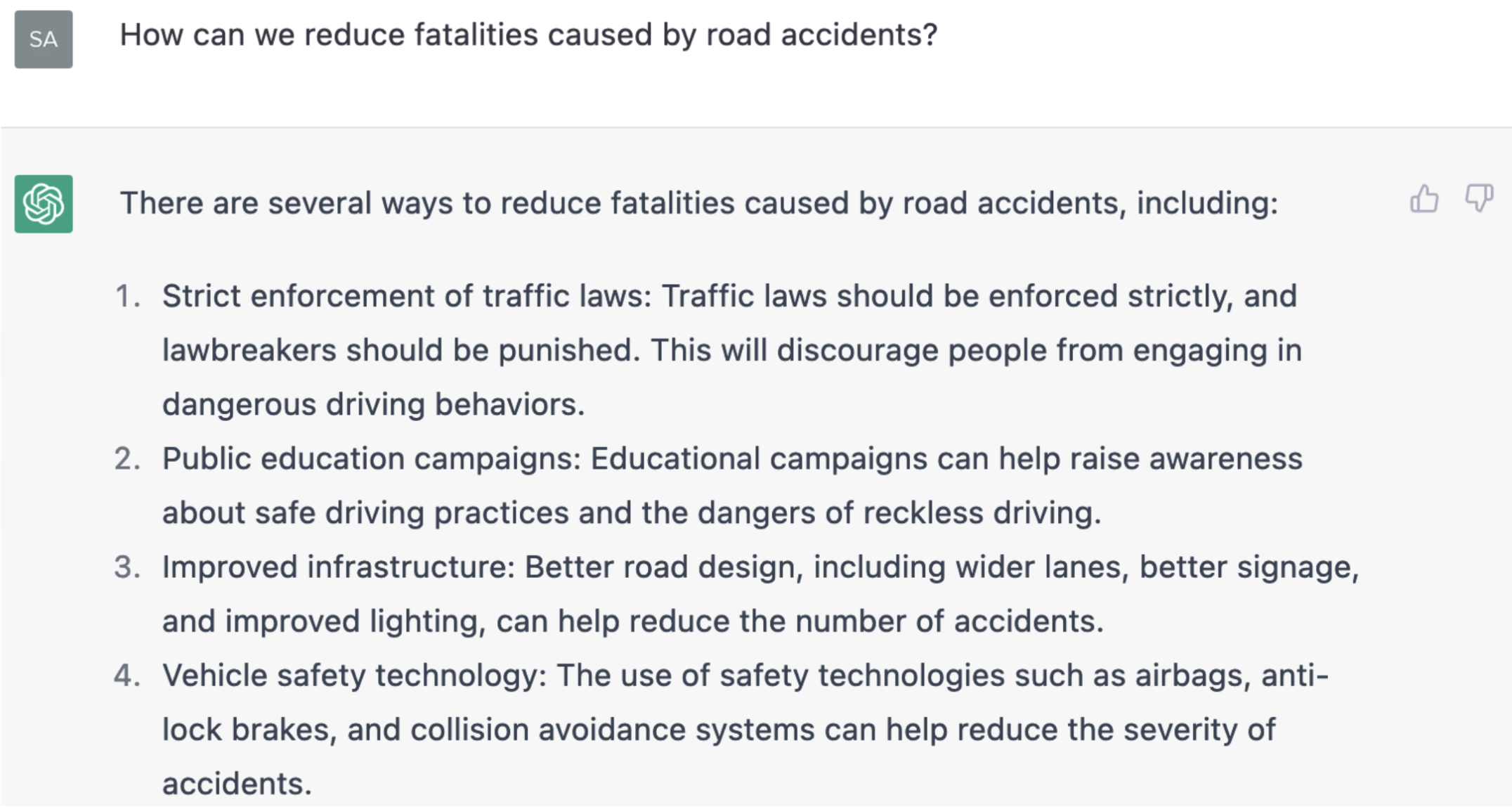ChatGPT and Road Safety: Exploring Solutions and Unlocking New Possibilities
ARTICLE BY SANA’A KHASAWNEH
There has been a growing interest in ChatGPT in the last few months because of its impressive language processing abilities and versatility in answering a wide range of questions. As an Artificial Intelligence (AI) language model, ChatGPT has the potential to revolutionize how we interact with technology and the internet. Its ability to understand languages and generate human-like responses has captured the attention of many, including researchers, businesses, and individuals interested in exploring AI's possibilities. This made me think about the multiple possibilities we can improve Road Safety using ChatGPT and other AI tools.
Everyone can access ChatGPT through OpenAI's website, where you can input text and receive responses from the AI. I tried it myself and asked about how we can reduce fatalities caused by “road accidents” and here is how AI responded:
As an AI language model, ChatGPT is constantly learning and improving based on the interactions it has with users. You can find answers to many questions using AI though it’s not always accurate. AI language models like ChatGPT are trained on vast amounts of data where they can generate relevant responses in multiple cases. AI language models, however, are imperfect and can make mistakes like humans. The accuracy of the generated answers depends on the quality of the data used to train the model and the complexity of the questions asked.
Feeling smarter than the AI, I corrected the term road accidents to road crashes, and here is how it responded:
It turns out that the AI's understanding is that while many road crashes are preventable, not all of them can be avoided. To enhance its comprehension of road safety principles, we need to train the AI on the safe system approach, vision zero, and the objectives of the 2nd decade of action on Road Safety.
However, it is a tool that is becoming part of our life and will definitely take over many traditional roles in the future. For this reason, it is important to explore it and find out how we can use it to improve our advocacy work in Road Safety.
After thorough research, we found the following methods where AI can play a role in saving lives:
Education: ChatGPT can be trained on road safety data and regulations to create educational content that is engaging and easy to understand. For example, ChatGPT can generate content about traffic rules, safe driving practices, and the importance of wearing seatbelts and helmets.
Awareness: ChatGPT can create awareness campaigns about road safety by generating stories and messages highlighting the risks and consequences of reckless driving.
Driver assistance: ChatGPT can be integrated into driver assistance systems or traffic management systems to provide real-time advice and guidance to drivers. For example, ChatGPT can alert drivers about road hazards, traffic congestion, and weather conditions.
Post-crash response: ChatGPT can be trained to generate a response for emergencies related to road crashes. It can advise on first aid measures, contact emergency services, and guide drivers and bystanders on their response.
Chatbots: ChatGPT can be used to develop chatbots that can assist drivers and passengers with road safety queries. A chatbot powered by ChatGPT can answer common questions about road safety, provide driving directions, and offer tips on driving in different weather conditions.
Storytelling: ChatGPT can assist in road safety storytelling by generating engaging and informative content that can capture the attention of the audience. Using natural language processing, ChatGPT can analyze and understand the language and tone of road safety stories and generate informative and engaging responses. This can help increase awareness and understanding of road safety issues among the general public, leading to safer driving behaviors and reduced road crashes.





